Economic Principle Report: Sugar Tax, Market Analysis, and Policy
VerifiedAdded on 2020/05/28
|9
|1386
|69
Report
AI Summary
This report delves into the economic principle of tax incidence, examining its impact on market dynamics and consumer behavior. The analysis begins with a definition of tax incidence and its effect on social welfare, followed by a microeconomic exploration of demand, supply, and elasticity. The report then uses market analysis, including figures, to illustrate the effects of a tax on sugar-sweetened drinks, considering both the taxed market and related markets such as sugar and non-sweetened beverages. The study investigates how the price elasticity of demand affects the distribution of the tax burden between buyers and sellers. Finally, it assesses the effectiveness of the tax policy, considering the varying demand elasticity among different consumer groups, such as children, teenagers, and low-income households, and how these factors influence the policy's success in reducing sugar consumption. The report concludes with a comprehensive review of relevant academic references.
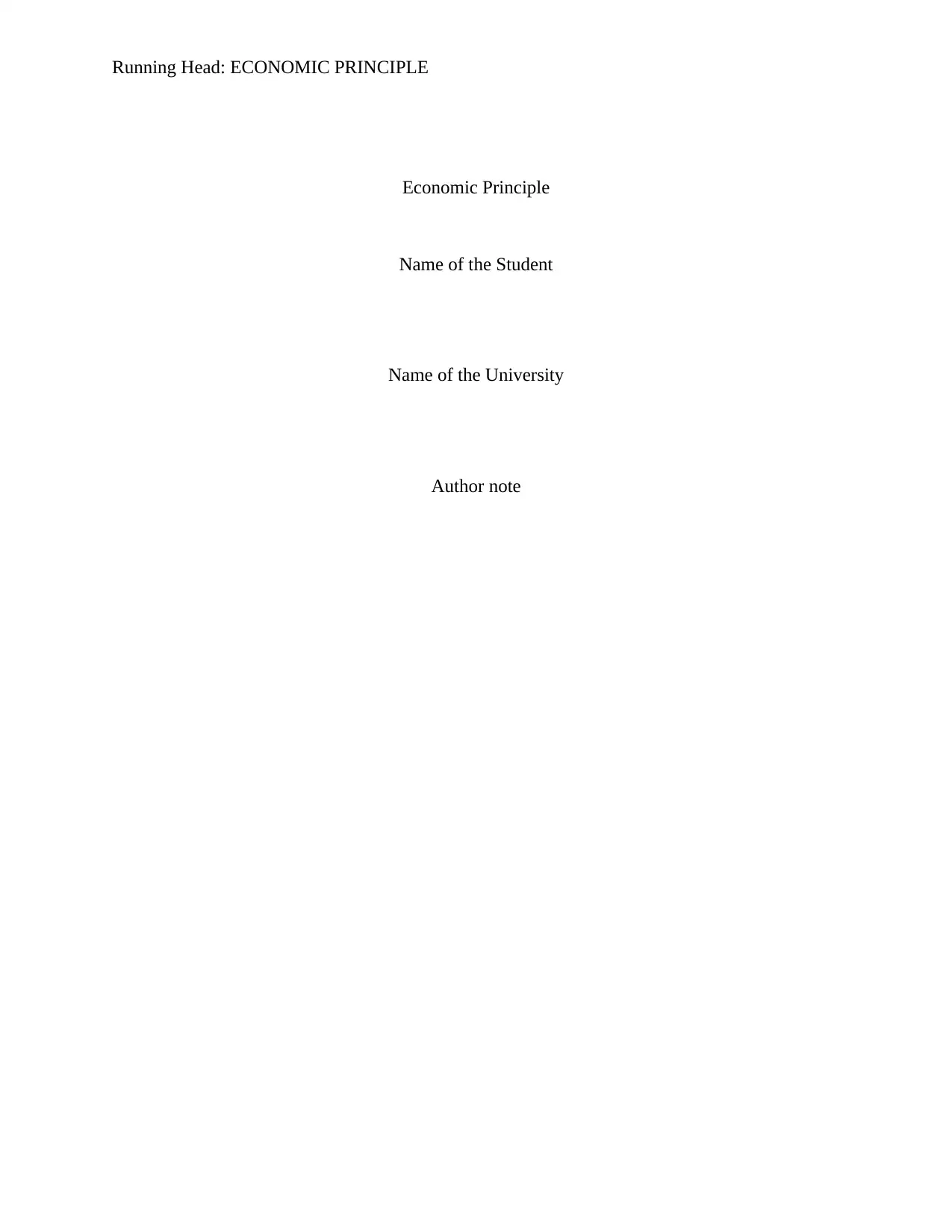
Running Head: ECONOMIC PRINCIPLE
Economic Principle
Name of the Student
Name of the University
Author note
Economic Principle
Name of the Student
Name of the University
Author note
Paraphrase This Document
Need a fresh take? Get an instant paraphrase of this document with our AI Paraphraser
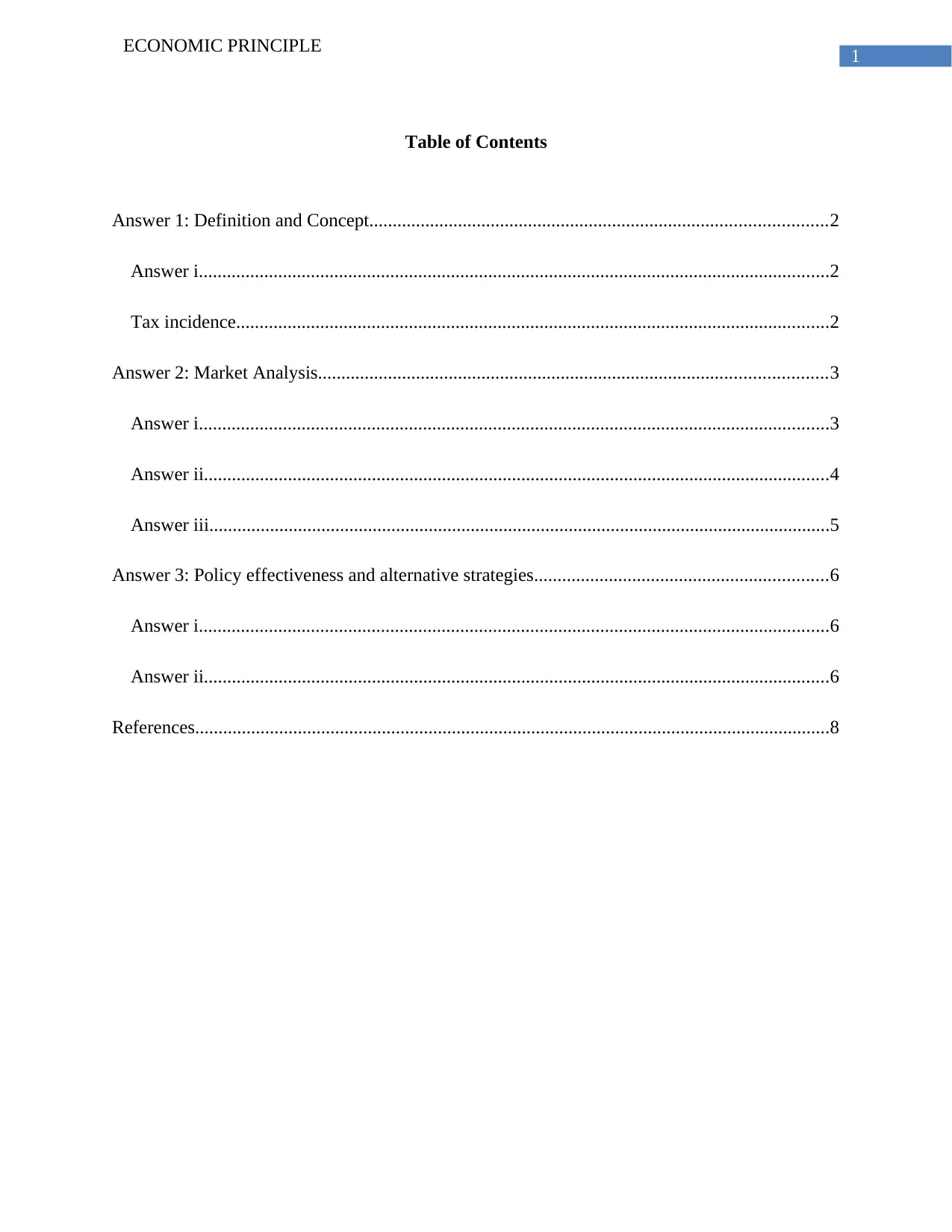
1
ECONOMIC PRINCIPLE
Table of Contents
Answer 1: Definition and Concept..................................................................................................2
Answer i.......................................................................................................................................2
Tax incidence...............................................................................................................................2
Answer 2: Market Analysis.............................................................................................................3
Answer i.......................................................................................................................................3
Answer ii......................................................................................................................................4
Answer iii.....................................................................................................................................5
Answer 3: Policy effectiveness and alternative strategies...............................................................6
Answer i.......................................................................................................................................6
Answer ii......................................................................................................................................6
References........................................................................................................................................8
ECONOMIC PRINCIPLE
Table of Contents
Answer 1: Definition and Concept..................................................................................................2
Answer i.......................................................................................................................................2
Tax incidence...............................................................................................................................2
Answer 2: Market Analysis.............................................................................................................3
Answer i.......................................................................................................................................3
Answer ii......................................................................................................................................4
Answer iii.....................................................................................................................................5
Answer 3: Policy effectiveness and alternative strategies...............................................................6
Answer i.......................................................................................................................................6
Answer ii......................................................................................................................................6
References........................................................................................................................................8
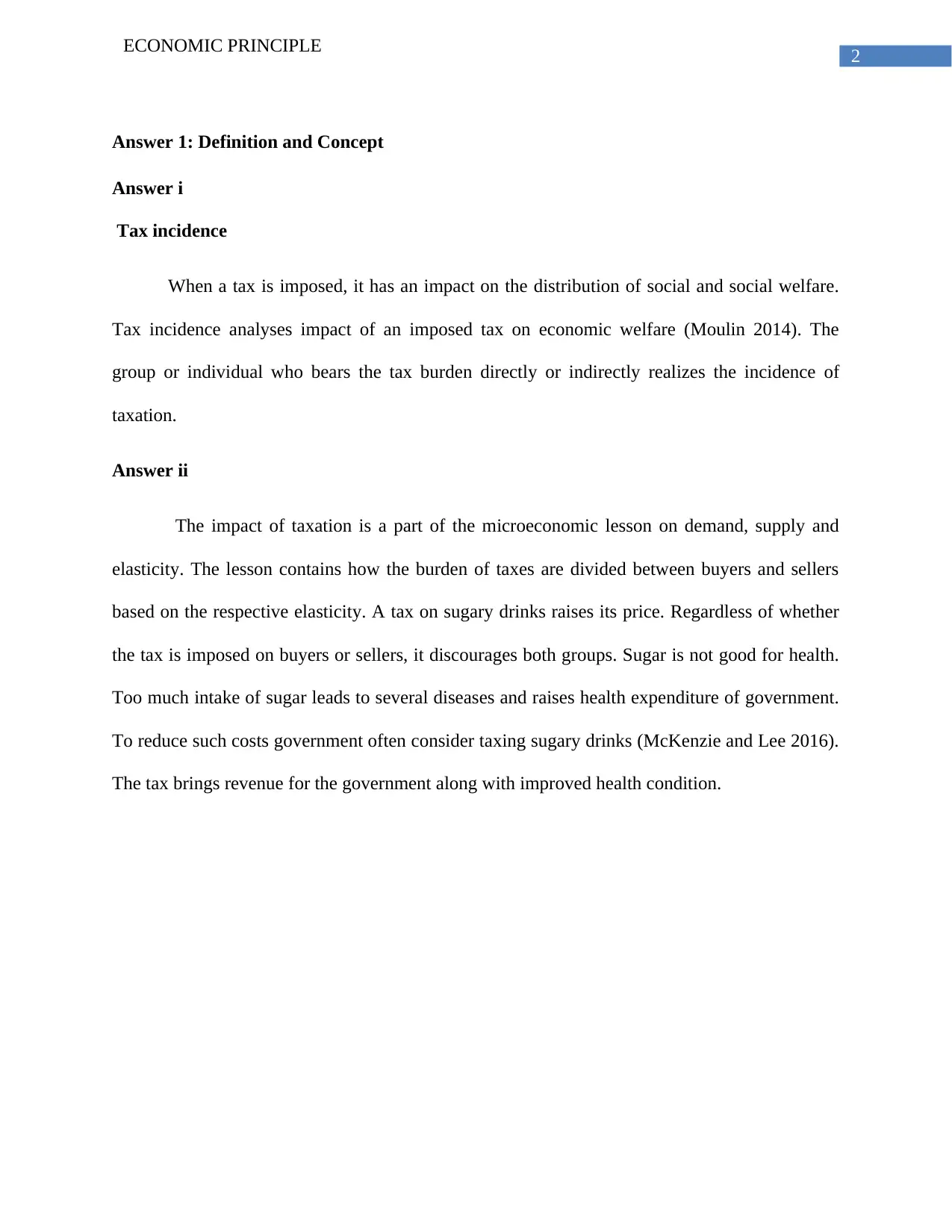
2
ECONOMIC PRINCIPLE
Answer 1: Definition and Concept
Answer i
Tax incidence
When a tax is imposed, it has an impact on the distribution of social and social welfare.
Tax incidence analyses impact of an imposed tax on economic welfare (Moulin 2014). The
group or individual who bears the tax burden directly or indirectly realizes the incidence of
taxation.
Answer ii
The impact of taxation is a part of the microeconomic lesson on demand, supply and
elasticity. The lesson contains how the burden of taxes are divided between buyers and sellers
based on the respective elasticity. A tax on sugary drinks raises its price. Regardless of whether
the tax is imposed on buyers or sellers, it discourages both groups. Sugar is not good for health.
Too much intake of sugar leads to several diseases and raises health expenditure of government.
To reduce such costs government often consider taxing sugary drinks (McKenzie and Lee 2016).
The tax brings revenue for the government along with improved health condition.
ECONOMIC PRINCIPLE
Answer 1: Definition and Concept
Answer i
Tax incidence
When a tax is imposed, it has an impact on the distribution of social and social welfare.
Tax incidence analyses impact of an imposed tax on economic welfare (Moulin 2014). The
group or individual who bears the tax burden directly or indirectly realizes the incidence of
taxation.
Answer ii
The impact of taxation is a part of the microeconomic lesson on demand, supply and
elasticity. The lesson contains how the burden of taxes are divided between buyers and sellers
based on the respective elasticity. A tax on sugary drinks raises its price. Regardless of whether
the tax is imposed on buyers or sellers, it discourages both groups. Sugar is not good for health.
Too much intake of sugar leads to several diseases and raises health expenditure of government.
To reduce such costs government often consider taxing sugary drinks (McKenzie and Lee 2016).
The tax brings revenue for the government along with improved health condition.
⊘ This is a preview!⊘
Do you want full access?
Subscribe today to unlock all pages.

Trusted by 1+ million students worldwide
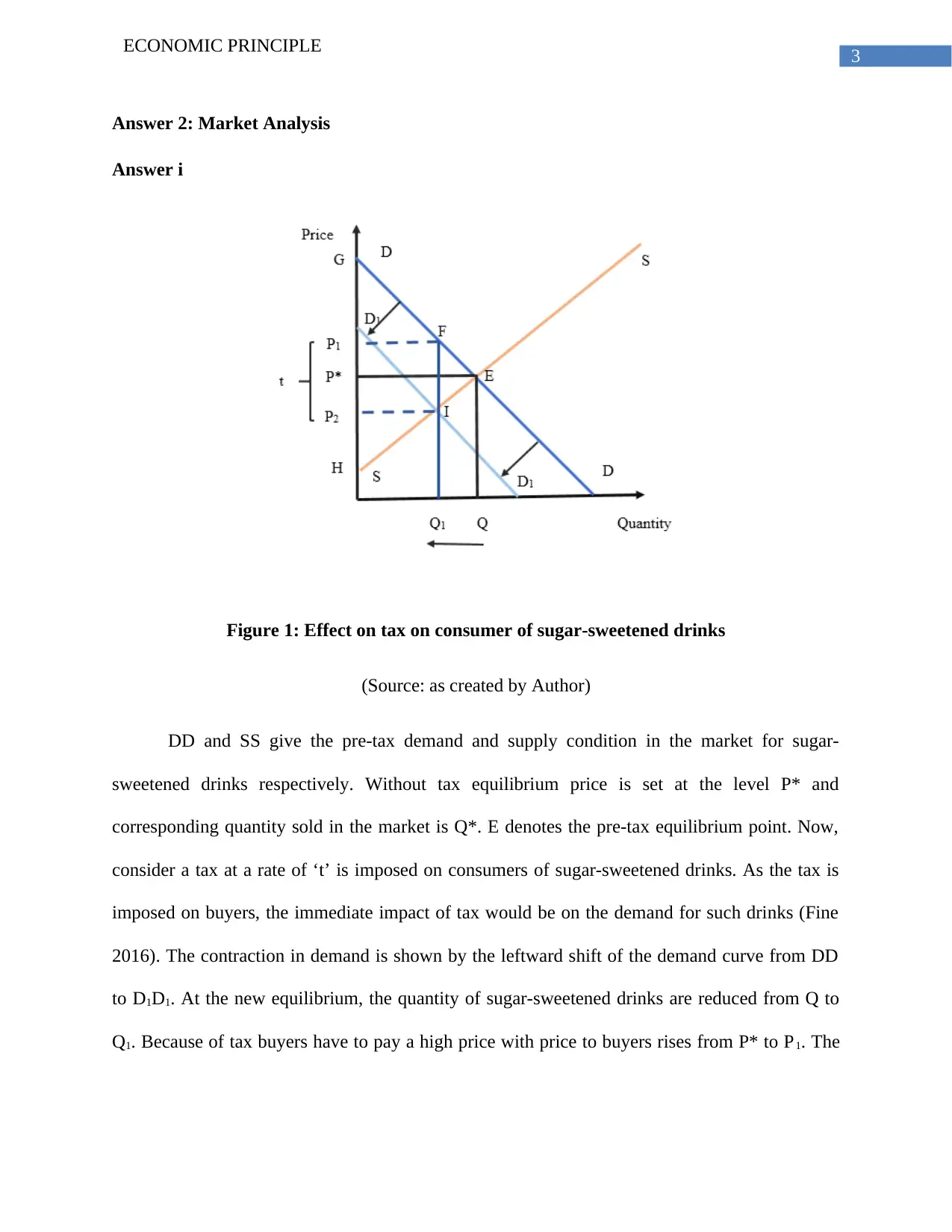
3
ECONOMIC PRINCIPLE
Answer 2: Market Analysis
Answer i
Figure 1: Effect on tax on consumer of sugar-sweetened drinks
(Source: as created by Author)
DD and SS give the pre-tax demand and supply condition in the market for sugar-
sweetened drinks respectively. Without tax equilibrium price is set at the level P* and
corresponding quantity sold in the market is Q*. E denotes the pre-tax equilibrium point. Now,
consider a tax at a rate of ‘t’ is imposed on consumers of sugar-sweetened drinks. As the tax is
imposed on buyers, the immediate impact of tax would be on the demand for such drinks (Fine
2016). The contraction in demand is shown by the leftward shift of the demand curve from DD
to D1D1. At the new equilibrium, the quantity of sugar-sweetened drinks are reduced from Q to
Q1. Because of tax buyers have to pay a high price with price to buyers rises from P* to P1. The
ECONOMIC PRINCIPLE
Answer 2: Market Analysis
Answer i
Figure 1: Effect on tax on consumer of sugar-sweetened drinks
(Source: as created by Author)
DD and SS give the pre-tax demand and supply condition in the market for sugar-
sweetened drinks respectively. Without tax equilibrium price is set at the level P* and
corresponding quantity sold in the market is Q*. E denotes the pre-tax equilibrium point. Now,
consider a tax at a rate of ‘t’ is imposed on consumers of sugar-sweetened drinks. As the tax is
imposed on buyers, the immediate impact of tax would be on the demand for such drinks (Fine
2016). The contraction in demand is shown by the leftward shift of the demand curve from DD
to D1D1. At the new equilibrium, the quantity of sugar-sweetened drinks are reduced from Q to
Q1. Because of tax buyers have to pay a high price with price to buyers rises from P* to P1. The
Paraphrase This Document
Need a fresh take? Get an instant paraphrase of this document with our AI Paraphraser
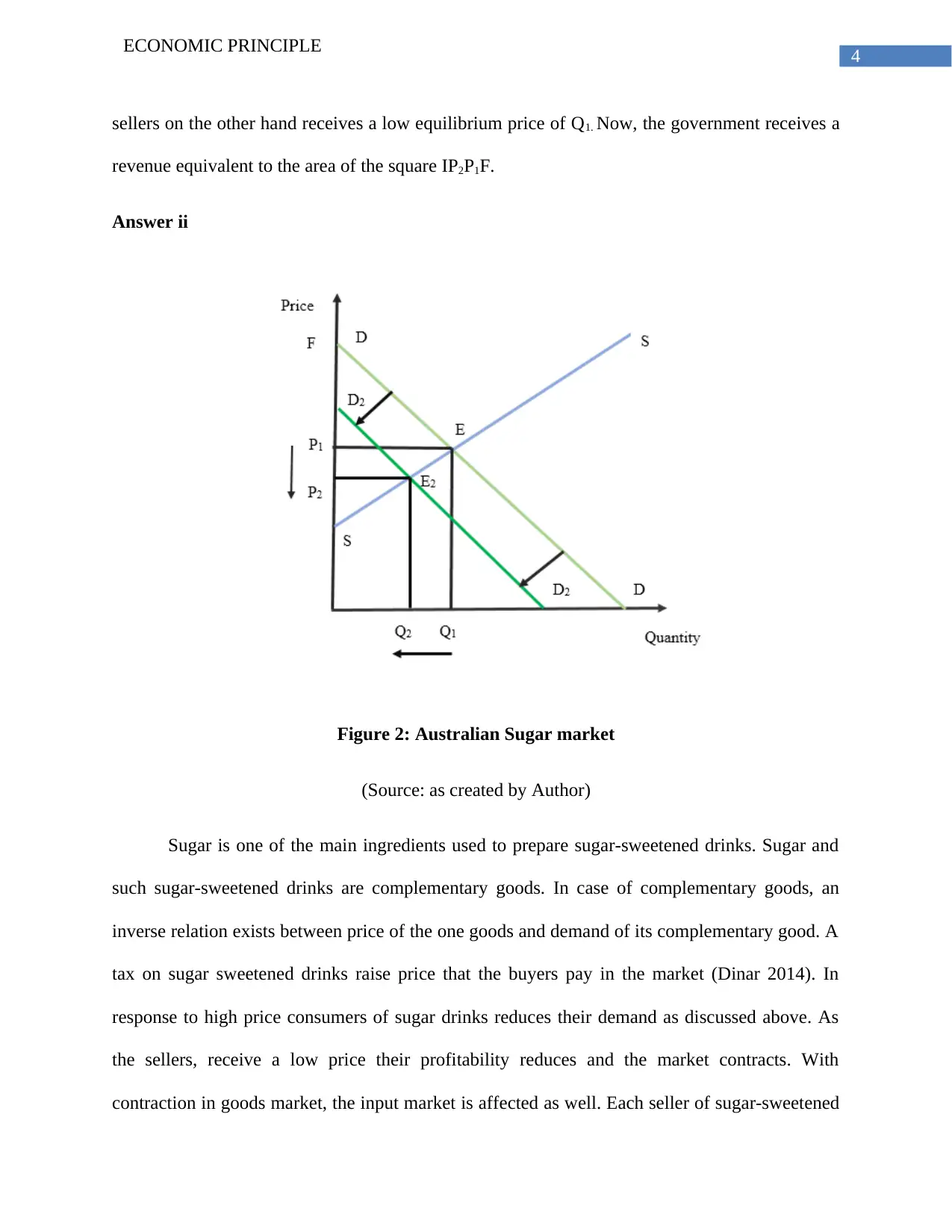
4
ECONOMIC PRINCIPLE
sellers on the other hand receives a low equilibrium price of Q1. Now, the government receives a
revenue equivalent to the area of the square IP2P1F.
Answer ii
Figure 2: Australian Sugar market
(Source: as created by Author)
Sugar is one of the main ingredients used to prepare sugar-sweetened drinks. Sugar and
such sugar-sweetened drinks are complementary goods. In case of complementary goods, an
inverse relation exists between price of the one goods and demand of its complementary good. A
tax on sugar sweetened drinks raise price that the buyers pay in the market (Dinar 2014). In
response to high price consumers of sugar drinks reduces their demand as discussed above. As
the sellers, receive a low price their profitability reduces and the market contracts. With
contraction in goods market, the input market is affected as well. Each seller of sugar-sweetened
ECONOMIC PRINCIPLE
sellers on the other hand receives a low equilibrium price of Q1. Now, the government receives a
revenue equivalent to the area of the square IP2P1F.
Answer ii
Figure 2: Australian Sugar market
(Source: as created by Author)
Sugar is one of the main ingredients used to prepare sugar-sweetened drinks. Sugar and
such sugar-sweetened drinks are complementary goods. In case of complementary goods, an
inverse relation exists between price of the one goods and demand of its complementary good. A
tax on sugar sweetened drinks raise price that the buyers pay in the market (Dinar 2014). In
response to high price consumers of sugar drinks reduces their demand as discussed above. As
the sellers, receive a low price their profitability reduces and the market contracts. With
contraction in goods market, the input market is affected as well. Each seller of sugar-sweetened
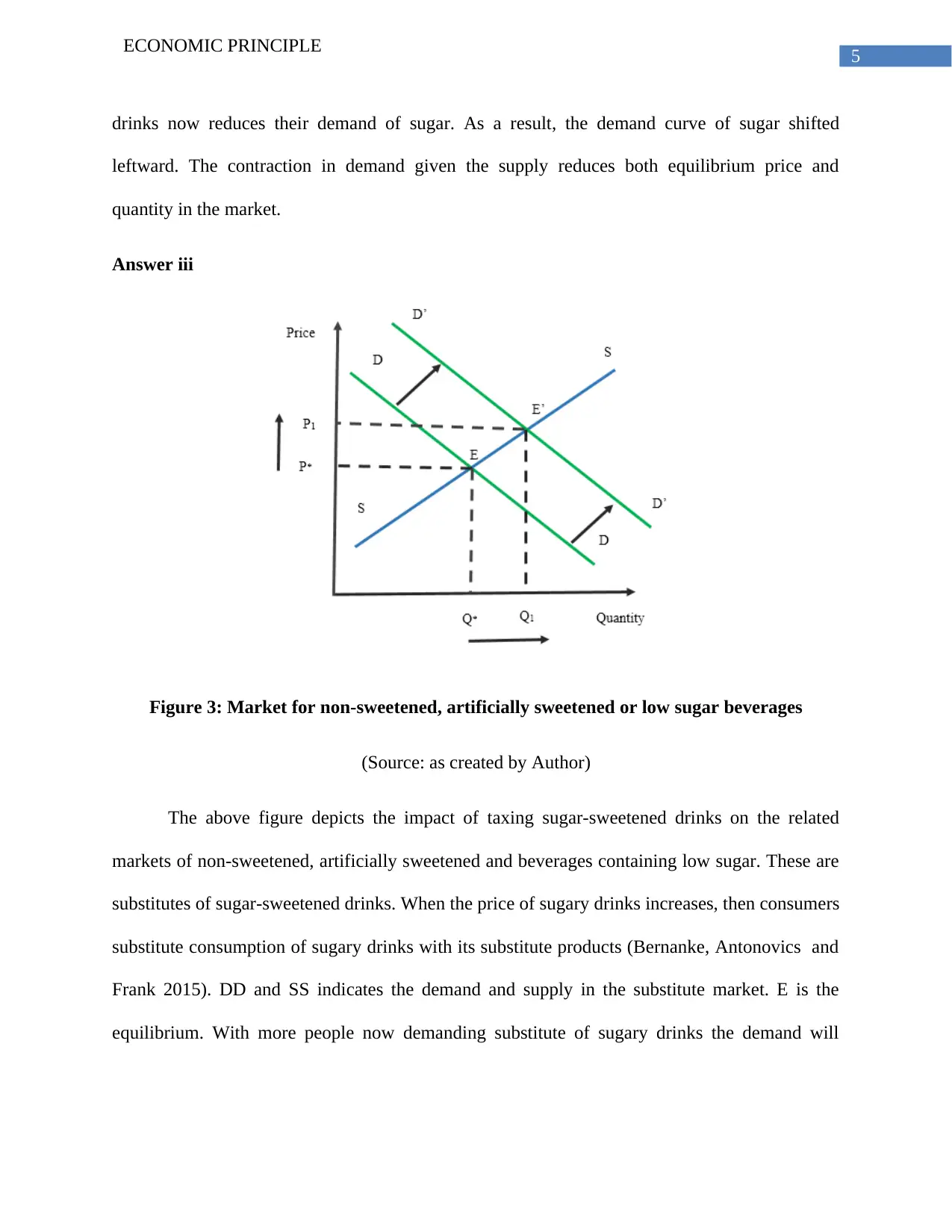
5
ECONOMIC PRINCIPLE
drinks now reduces their demand of sugar. As a result, the demand curve of sugar shifted
leftward. The contraction in demand given the supply reduces both equilibrium price and
quantity in the market.
Answer iii
Figure 3: Market for non-sweetened, artificially sweetened or low sugar beverages
(Source: as created by Author)
The above figure depicts the impact of taxing sugar-sweetened drinks on the related
markets of non-sweetened, artificially sweetened and beverages containing low sugar. These are
substitutes of sugar-sweetened drinks. When the price of sugary drinks increases, then consumers
substitute consumption of sugary drinks with its substitute products (Bernanke, Antonovics and
Frank 2015). DD and SS indicates the demand and supply in the substitute market. E is the
equilibrium. With more people now demanding substitute of sugary drinks the demand will
ECONOMIC PRINCIPLE
drinks now reduces their demand of sugar. As a result, the demand curve of sugar shifted
leftward. The contraction in demand given the supply reduces both equilibrium price and
quantity in the market.
Answer iii
Figure 3: Market for non-sweetened, artificially sweetened or low sugar beverages
(Source: as created by Author)
The above figure depicts the impact of taxing sugar-sweetened drinks on the related
markets of non-sweetened, artificially sweetened and beverages containing low sugar. These are
substitutes of sugar-sweetened drinks. When the price of sugary drinks increases, then consumers
substitute consumption of sugary drinks with its substitute products (Bernanke, Antonovics and
Frank 2015). DD and SS indicates the demand and supply in the substitute market. E is the
equilibrium. With more people now demanding substitute of sugary drinks the demand will
⊘ This is a preview!⊘
Do you want full access?
Subscribe today to unlock all pages.

Trusted by 1+ million students worldwide
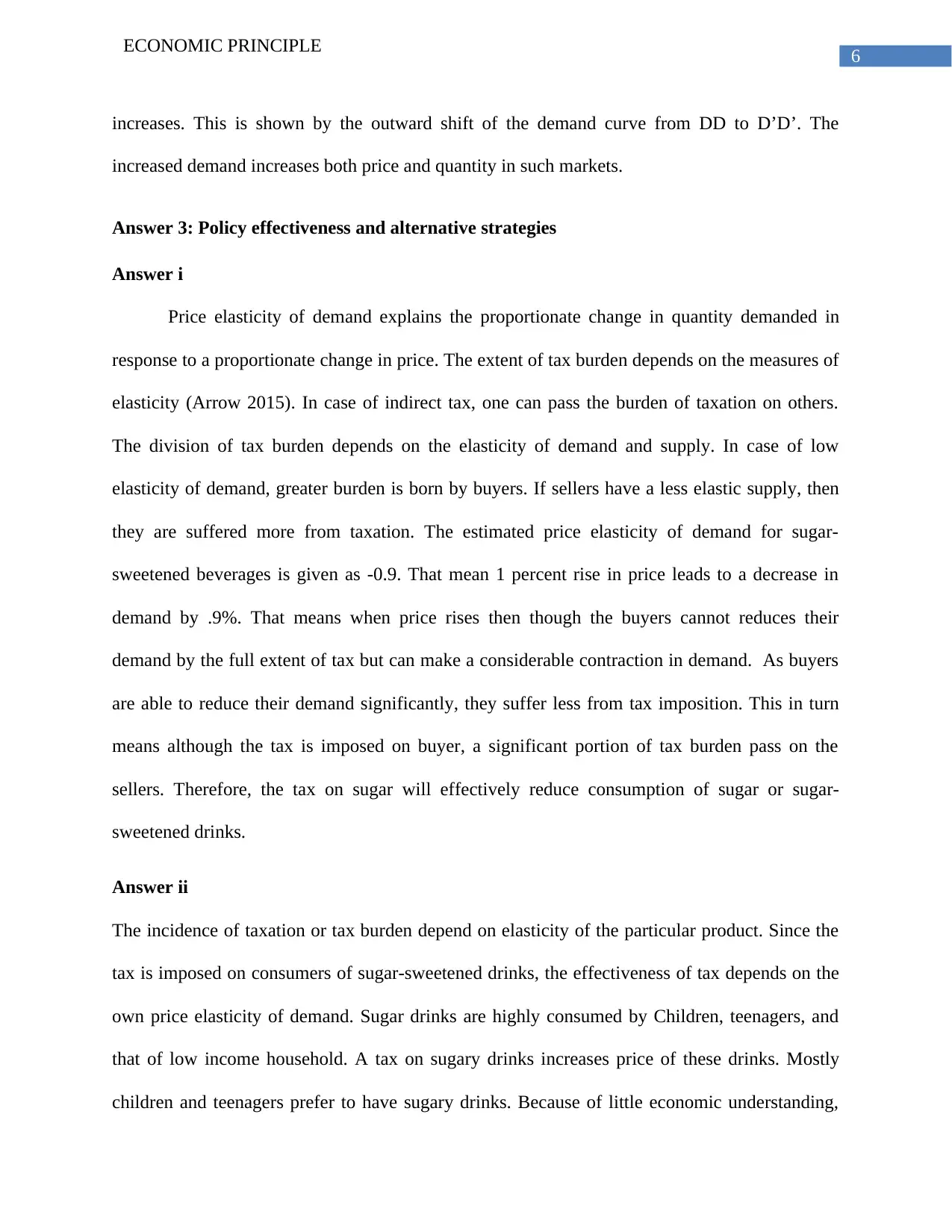
6
ECONOMIC PRINCIPLE
increases. This is shown by the outward shift of the demand curve from DD to D’D’. The
increased demand increases both price and quantity in such markets.
Answer 3: Policy effectiveness and alternative strategies
Answer i
Price elasticity of demand explains the proportionate change in quantity demanded in
response to a proportionate change in price. The extent of tax burden depends on the measures of
elasticity (Arrow 2015). In case of indirect tax, one can pass the burden of taxation on others.
The division of tax burden depends on the elasticity of demand and supply. In case of low
elasticity of demand, greater burden is born by buyers. If sellers have a less elastic supply, then
they are suffered more from taxation. The estimated price elasticity of demand for sugar-
sweetened beverages is given as -0.9. That mean 1 percent rise in price leads to a decrease in
demand by .9%. That means when price rises then though the buyers cannot reduces their
demand by the full extent of tax but can make a considerable contraction in demand. As buyers
are able to reduce their demand significantly, they suffer less from tax imposition. This in turn
means although the tax is imposed on buyer, a significant portion of tax burden pass on the
sellers. Therefore, the tax on sugar will effectively reduce consumption of sugar or sugar-
sweetened drinks.
Answer ii
The incidence of taxation or tax burden depend on elasticity of the particular product. Since the
tax is imposed on consumers of sugar-sweetened drinks, the effectiveness of tax depends on the
own price elasticity of demand. Sugar drinks are highly consumed by Children, teenagers, and
that of low income household. A tax on sugary drinks increases price of these drinks. Mostly
children and teenagers prefer to have sugary drinks. Because of little economic understanding,
ECONOMIC PRINCIPLE
increases. This is shown by the outward shift of the demand curve from DD to D’D’. The
increased demand increases both price and quantity in such markets.
Answer 3: Policy effectiveness and alternative strategies
Answer i
Price elasticity of demand explains the proportionate change in quantity demanded in
response to a proportionate change in price. The extent of tax burden depends on the measures of
elasticity (Arrow 2015). In case of indirect tax, one can pass the burden of taxation on others.
The division of tax burden depends on the elasticity of demand and supply. In case of low
elasticity of demand, greater burden is born by buyers. If sellers have a less elastic supply, then
they are suffered more from taxation. The estimated price elasticity of demand for sugar-
sweetened beverages is given as -0.9. That mean 1 percent rise in price leads to a decrease in
demand by .9%. That means when price rises then though the buyers cannot reduces their
demand by the full extent of tax but can make a considerable contraction in demand. As buyers
are able to reduce their demand significantly, they suffer less from tax imposition. This in turn
means although the tax is imposed on buyer, a significant portion of tax burden pass on the
sellers. Therefore, the tax on sugar will effectively reduce consumption of sugar or sugar-
sweetened drinks.
Answer ii
The incidence of taxation or tax burden depend on elasticity of the particular product. Since the
tax is imposed on consumers of sugar-sweetened drinks, the effectiveness of tax depends on the
own price elasticity of demand. Sugar drinks are highly consumed by Children, teenagers, and
that of low income household. A tax on sugary drinks increases price of these drinks. Mostly
children and teenagers prefer to have sugary drinks. Because of little economic understanding,
Paraphrase This Document
Need a fresh take? Get an instant paraphrase of this document with our AI Paraphraser
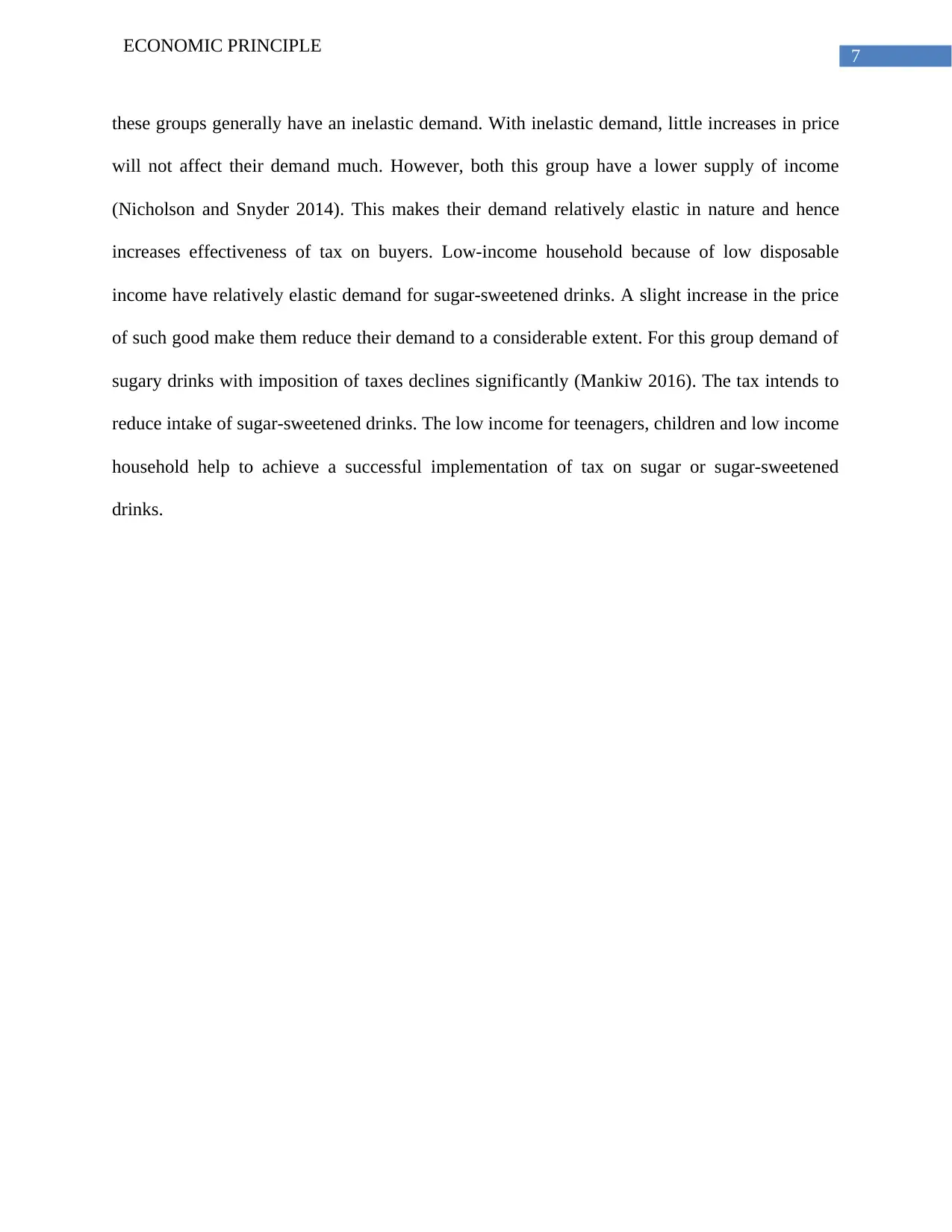
7
ECONOMIC PRINCIPLE
these groups generally have an inelastic demand. With inelastic demand, little increases in price
will not affect their demand much. However, both this group have a lower supply of income
(Nicholson and Snyder 2014). This makes their demand relatively elastic in nature and hence
increases effectiveness of tax on buyers. Low-income household because of low disposable
income have relatively elastic demand for sugar-sweetened drinks. A slight increase in the price
of such good make them reduce their demand to a considerable extent. For this group demand of
sugary drinks with imposition of taxes declines significantly (Mankiw 2016). The tax intends to
reduce intake of sugar-sweetened drinks. The low income for teenagers, children and low income
household help to achieve a successful implementation of tax on sugar or sugar-sweetened
drinks.
ECONOMIC PRINCIPLE
these groups generally have an inelastic demand. With inelastic demand, little increases in price
will not affect their demand much. However, both this group have a lower supply of income
(Nicholson and Snyder 2014). This makes their demand relatively elastic in nature and hence
increases effectiveness of tax on buyers. Low-income household because of low disposable
income have relatively elastic demand for sugar-sweetened drinks. A slight increase in the price
of such good make them reduce their demand to a considerable extent. For this group demand of
sugary drinks with imposition of taxes declines significantly (Mankiw 2016). The tax intends to
reduce intake of sugar-sweetened drinks. The low income for teenagers, children and low income
household help to achieve a successful implementation of tax on sugar or sugar-sweetened
drinks.
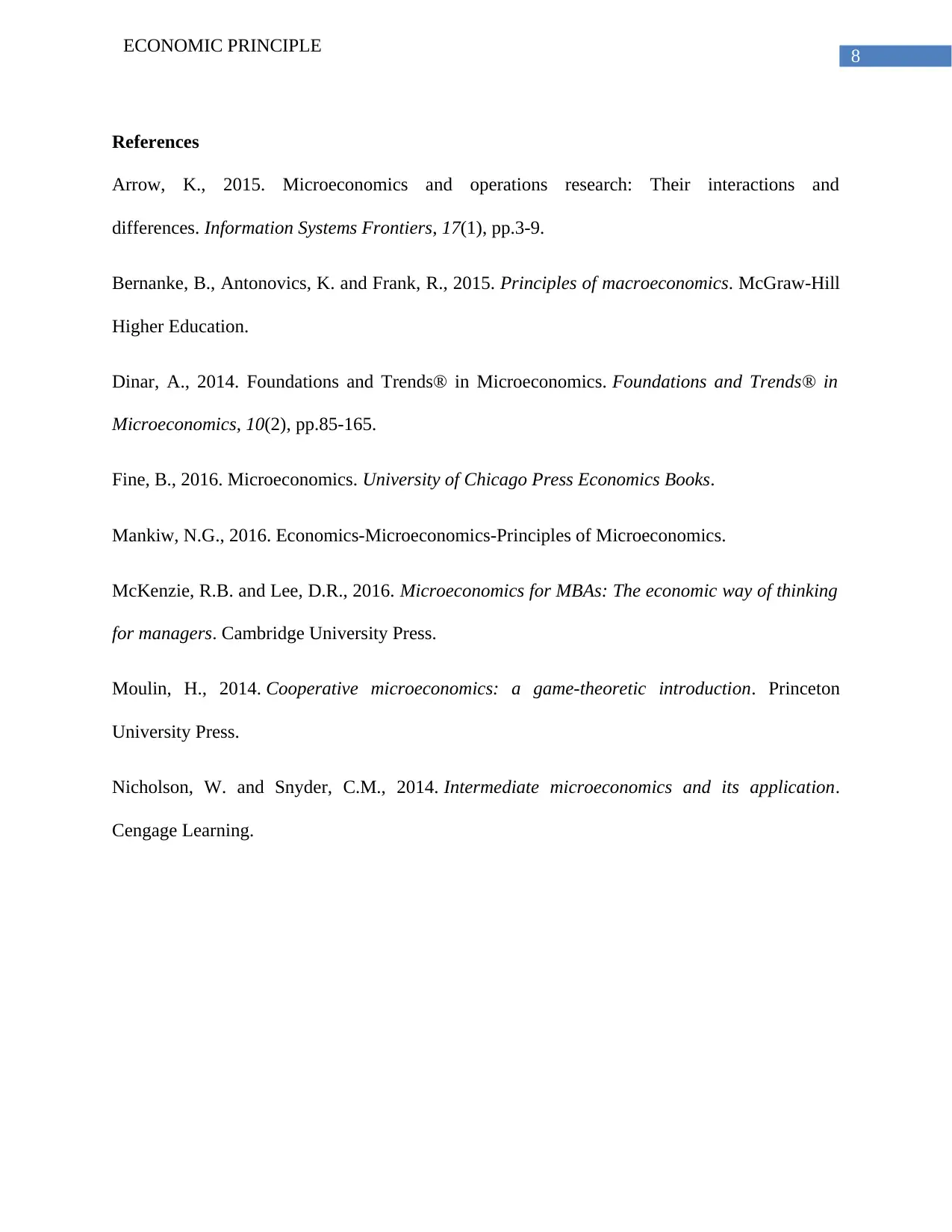
8
ECONOMIC PRINCIPLE
References
Arrow, K., 2015. Microeconomics and operations research: Their interactions and
differences. Information Systems Frontiers, 17(1), pp.3-9.
Bernanke, B., Antonovics, K. and Frank, R., 2015. Principles of macroeconomics. McGraw-Hill
Higher Education.
Dinar, A., 2014. Foundations and Trends® in Microeconomics. Foundations and Trends® in
Microeconomics, 10(2), pp.85-165.
Fine, B., 2016. Microeconomics. University of Chicago Press Economics Books.
Mankiw, N.G., 2016. Economics-Microeconomics-Principles of Microeconomics.
McKenzie, R.B. and Lee, D.R., 2016. Microeconomics for MBAs: The economic way of thinking
for managers. Cambridge University Press.
Moulin, H., 2014. Cooperative microeconomics: a game-theoretic introduction. Princeton
University Press.
Nicholson, W. and Snyder, C.M., 2014. Intermediate microeconomics and its application.
Cengage Learning.
ECONOMIC PRINCIPLE
References
Arrow, K., 2015. Microeconomics and operations research: Their interactions and
differences. Information Systems Frontiers, 17(1), pp.3-9.
Bernanke, B., Antonovics, K. and Frank, R., 2015. Principles of macroeconomics. McGraw-Hill
Higher Education.
Dinar, A., 2014. Foundations and Trends® in Microeconomics. Foundations and Trends® in
Microeconomics, 10(2), pp.85-165.
Fine, B., 2016. Microeconomics. University of Chicago Press Economics Books.
Mankiw, N.G., 2016. Economics-Microeconomics-Principles of Microeconomics.
McKenzie, R.B. and Lee, D.R., 2016. Microeconomics for MBAs: The economic way of thinking
for managers. Cambridge University Press.
Moulin, H., 2014. Cooperative microeconomics: a game-theoretic introduction. Princeton
University Press.
Nicholson, W. and Snyder, C.M., 2014. Intermediate microeconomics and its application.
Cengage Learning.
⊘ This is a preview!⊘
Do you want full access?
Subscribe today to unlock all pages.

Trusted by 1+ million students worldwide
1 out of 9
Related Documents
Your All-in-One AI-Powered Toolkit for Academic Success.
+13062052269
info@desklib.com
Available 24*7 on WhatsApp / Email
![[object Object]](/_next/static/media/star-bottom.7253800d.svg)
Unlock your academic potential
Copyright © 2020–2025 A2Z Services. All Rights Reserved. Developed and managed by ZUCOL.





